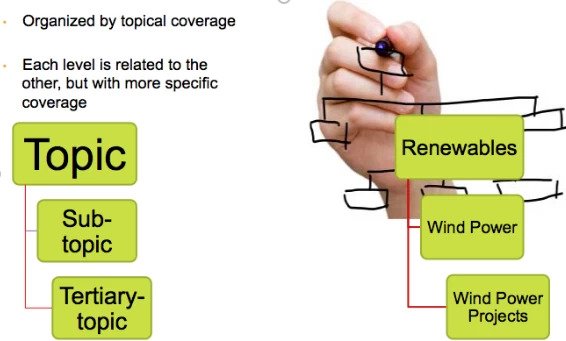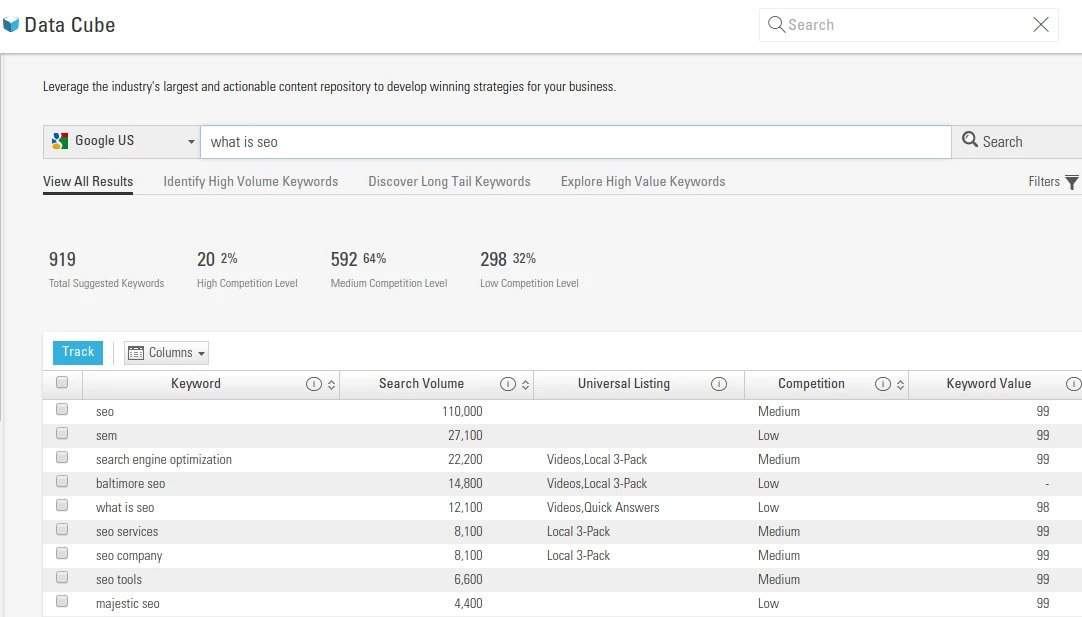Content silos are the second part of a three-part strategy. Explore Part 1 and Part 3 of Michael's in-depth series. When people hear that they need to improve their SEO and content marketing efforts, they often jump feet first into blogging. Unfortunately, without a strong website architecture, the potential impact of blogging is greatly diminished. Countless businesses create a flat website structure, which means that they have their website or blog, but they are not organized based on a clear content hierarchy. Often the blog covers a range of different topics, but there is little organization to the posts. They all have completely unique URLs and they have random internal links that take readers all around the blog, haphazardly crossing topic lines. These links are more for the sake of linking, rather than as a part of a useful SEO strategy to provide structure to the blog and improve comprehension. Google states clearly in its Webmaster Guidelines, “Design your page to have a clear conceptual hierarchy.” The establishment of this type of structure makes it obvious to the search engine your level of expertise in the subject and the depth of the experience you are able to provide for a user seeking answers in this particular area. The best way to fulfill this technical SEO criteria is by developing content silos.
What is a content silo?
Content silo structuring describes a form of technical SEO that helps you organize your material based on relevant content. In a content silo, you will have several layers of material for a particular topic. At the top you will have a more general page that answers a broad question, for example, “What is SEO?” Each layer below that general topic dives more deeply into related subjects.  Your “What is SEO?” silo might be divided into “On-Page SEO” and “Off-Page SEO.” On the third level, your “On-Page SEO” might be divided into pages that deal with topics related to keyword research or alt tags, while “Off-Page SEO” will look at topics related to influencer marketing, building backlinks, and social media. A content silo allows you to organize content based upon user needs and search behavior so you can maximize the traffic you capture and your brand reach. You will research the topics that matter the most to your audience and be able to create an organized grouping of content that will explore their topic of interest thoroughly, allowing them to click on different links and learn about related ideas. This will firmly establish your brand as an authority in the field.
Your “What is SEO?” silo might be divided into “On-Page SEO” and “Off-Page SEO.” On the third level, your “On-Page SEO” might be divided into pages that deal with topics related to keyword research or alt tags, while “Off-Page SEO” will look at topics related to influencer marketing, building backlinks, and social media. A content silo allows you to organize content based upon user needs and search behavior so you can maximize the traffic you capture and your brand reach. You will research the topics that matter the most to your audience and be able to create an organized grouping of content that will explore their topic of interest thoroughly, allowing them to click on different links and learn about related ideas. This will firmly establish your brand as an authority in the field.
The connection between the content silo and the semantic web
The goal of technical SEO is to build a stronger, more efficient site. With content silos, you are able to organize your pages so that users can easily find their way around the domain and learn more about the topics that interest them. Google understands how your site is organized by following internal links, so the silos also help Google see the expertise you have in a particular area. Since the silos help you organize your thoughts and ideas and build categories around topics, you are also able to clearly demonstrate competence in a particular area, which will then help establish your domain authority. It is also important to note that the major Google updates in the past few years, including RankBrain and Hummingbird, have also forced a major shift in emphasis in content development. Prior to these algorithm updates, keywords were the cornerstone of helping Google understand your relevance to a particular topic. RankBrain and Hummingbird, however, are more oriented towards semantic search--the understanding of user intent and context. That means they do not just match keywords in queries to those in text. Instead, the algorithm uses semantics to "understand" text by looking at the language used throughout the material to grasp the meaning and relevance. When you create silos, you will naturally develop text and visuals around the common questions within a particular topic area. Since the content will be connected, Google will be able to "see" that you are an authority on the subject and that your material is highly relevant for the semantic web. A content silo, therefore helps you make your content more appealing to the intent-centered practices of the modern Google algorithm.
How do I use silos in my SEO strategy?
Silo structuring for your content requires breaking down your material into various categories and beginning to rank the pages as the top page for that topic, a secondary page, or a tertiary page. Since these silos are being constructed as part of a technical SEO strategy, however, it is important that you make these categories wisely. Base each category upon search volume, user behavior, and your buyer’s journey--or conversion path. Remember, silos are intended for your visitors first, and are a central part of the UX design. Search engines, and helping them understand the website’s topical and contextual meaning, are the secondary target. Ultimately, the ideal strategy is to closely align your content coverage to high-performing and extremely relevant keyword groupings at each level of the silo. Each topical name should represent a high-performing head-term. The topic will then have a keyword universe that is tightly correlated with the head term and the content coverage found at each level, therefore providing semantically relevant words for the silo. Tools like BrightEdge Data Cube, Google Keyword Planner and BrightEdge Recommendations can make it easy to pinpoint important keywords that can be broken down into the different levels of the silo. You can use the tools to explore the different subtopics that are commonly associated with your main keyword, better understanding the material that users and Google will want to see at each level of the silo.  You can use Data Cube, pictured above, to find related keywords that can help you build your silos. Keep in mind that each level of the silo also serves a very specific purpose in the buyer’s journey. Therefore, many of the top-level and secondary pages may serve as aggregators for that topic’s content. Links within the content will encourage people to move further through the buyer’s journey, further engaging with the brand and guiding them closer to conversion. Think of an ecommerce website that sells clothing. One silo may be Women’s Clothing > Jackets > Winter Jackets. Another example may be a blog covering renewable energy, where the silos represent the various types of renewables. For example: Wind Power > Wind Power Projects. As people progress through the silos, they learn more specifically about the organization’s depth of knowledge and what they have to offer about the different subjects. They build their relationship with the brand and eventually get closer to a website conversion. As you begin to organize the content into these categories, you may also find it beneficial to use your URLs to further emphasize your silos. For example, a URL that says yourexample.com/blog/seo/offpage/influencer-marketing will clearly indicate that this is a tertiary level of the silo and that it is a page under the Off-Page heading, which falls under the SEO category of the blog. Structuring your URL this way not only boosts your UX strategy and helps Google to understand your site, but it also makes it easy for people to see where they are in your site and how they can get to other sections they might be interested in reading. Content pages can be located within a specific URL silo, but often content belongs to multiple silos. For example Women’s Red Puffer Jacket could display in silos covering:
You can use Data Cube, pictured above, to find related keywords that can help you build your silos. Keep in mind that each level of the silo also serves a very specific purpose in the buyer’s journey. Therefore, many of the top-level and secondary pages may serve as aggregators for that topic’s content. Links within the content will encourage people to move further through the buyer’s journey, further engaging with the brand and guiding them closer to conversion. Think of an ecommerce website that sells clothing. One silo may be Women’s Clothing > Jackets > Winter Jackets. Another example may be a blog covering renewable energy, where the silos represent the various types of renewables. For example: Wind Power > Wind Power Projects. As people progress through the silos, they learn more specifically about the organization’s depth of knowledge and what they have to offer about the different subjects. They build their relationship with the brand and eventually get closer to a website conversion. As you begin to organize the content into these categories, you may also find it beneficial to use your URLs to further emphasize your silos. For example, a URL that says yourexample.com/blog/seo/offpage/influencer-marketing will clearly indicate that this is a tertiary level of the silo and that it is a page under the Off-Page heading, which falls under the SEO category of the blog. Structuring your URL this way not only boosts your UX strategy and helps Google to understand your site, but it also makes it easy for people to see where they are in your site and how they can get to other sections they might be interested in reading. Content pages can be located within a specific URL silo, but often content belongs to multiple silos. For example Women’s Red Puffer Jacket could display in silos covering:
- Women’s jackets
- Puffer Jackets
- Red Jackets
Depending on how your site is architected, you could easily end up with duplicate content. Canonicals can help resolve that sort of problem, but it’s better to address it with clean silo architecture. This issue is discussed further in the taxonomy and semantics parts of this series, but here is an overview. There are numerous approaches to solve this problem. One approach is to have the content reside alongside the top level of the taxonomy. In this example, content would display something like this:
https://www.domain.com/content/name-of-my-new-blog-post.html
This solves the problem of potential duplicate content, while also placing the content higher in the website architecture, which provides greater authority. Furthermore, many SEOs agree that having a page closer to the root domain or home page may provide an authority boost. Including the targeted keyword or latent semantic indexing keywords in the URL can increase that boost. Technical SEO should never be neglected. Building a content silo is an effective means of keeping material organized, helping both your readers engage with your site and Google to understand your authority and expertise. Silos make it easy to organize your site with deep structures and a clear content hierarchy. Brands who want to see genuine results from their content production efforts need to work on developing strong silos to maximize the effectiveness of their efforts.


